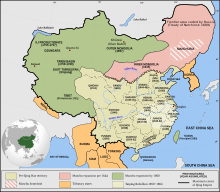Secession in China
This article needs additional citations for verification. (July 2020) |


Secession in China refers to several secessionist movements in the People's Republic of China.
Legal basis
People’s Republic of China
The 1931 constitution of the Chinese Communist Party accepted secession as legal with article 14 stating “The Soviet government of China recognizes the right of self-determination of the national minorities in China, their right to complete separation from China, and to the formation of an independent state for each national minority.” However, the CCP's change from a revolutionary group to the dominant state power in 1949 led to this language being left out of later constitutions and any legal chance for secession disappeared from Chinese law.[1]
List of secessionist movements in the People's Republic of China
| Claimed region | Current political status within the PRC | Capital city of region | Area (km2) of region | Total population of region | Main independence movement | Main ethnic group seeking independence | Population of independence-seeking ethnic group |
|---|---|---|---|---|---|---|---|
| Uyghur Autonomous Region of the PRC | Ürümqi | 1,664,897 | 24,870,000 | East Turkestan independence movement | Uyghur people | 12,123,000 (in China) or ~13,500,000 (globally) | |
| Special Administrative Region of the PRC | Hong Kong | 2,755 | 7,500,700 | Hong Kong independence movement | Hong Kong people
(any resident of Hong Kong; mostly ethnic-Cantonese) |
7,234,800 (in Hong Kong)
or ~8,600,000 (globally) | |
| Special Administrative Region of the PRC | Macau | 115 | 696,100 | Macau independence movement | Macau people
(any resident of Macau; mostly ethnic-Cantonese) |
642,753 (in Macau) or ~710,000 (globally) | |
| Provinces of the PRC | Hsinking (Changchun) | 791,826 | 109,674,521 | Manchukuo Temporary Government | Manchu people | 10,410,585 (in China) or ~10,430,000 (globally) | |
| Autonomous Region of the PRC | Hohhot | 1,183,000 | 25,050,000 | Inner Mongolian independence movement | Chinese Mongols or Mongols | 5,981,840 (in China) or ~10,000,000 (globally) | |
| Autonomous Region of the PRC; Province of the PRC | Lhasa | 1,948,400 | 8,806,722 | Tibetan independence movement | Tibetan people | ~6,300,000 (in China) or ~6,500,000 (globally) |
Other
Region-specific
- Fujian People's Government
- Historical independence movement in the context of the Chinese Civil War and Chinese Warlord Era (Republic of China era) in the province of Fujian.
- 广东独立运动 (Guangdong/Cantonese independence movement, Cantonese nationalism)
- 湖南省独立运动 (Hunan independence movement)
- 兩廣共和國 (Liangguang Republic)
- The term 'Liangguang' refers to a combination of the provinces of Guangdong and Guangxi. It was an historical administrative division of China during the Qing dynasty era. The island province of Hainan also used to be part of Guangdong and, by extension, Liangguang.
- 上海自治运动 (Shanghai autonomy movement)
General
Notes
 Taiwan, a state with limited recognition whose territory is claimed as China's 23rd province, is not included in this list because it has never been governed by the People's Republic of China, the government that was established in mainland China in 1949. For more information, see articles; political status of Taiwan and Taiwan independence movement.
Taiwan, a state with limited recognition whose territory is claimed as China's 23rd province, is not included in this list because it has never been governed by the People's Republic of China, the government that was established in mainland China in 1949. For more information, see articles; political status of Taiwan and Taiwan independence movement.
Movements

Tibet
After the failed Tibetan uprising, some Tibetans followed the Dalai Lama into India, establishing a government-in-exile called the Central Tibetan Administration.[2]
The movement is no longer supported by the 14th Dalai Lama, who although having advocated it from 1961 to the late 1970s, proposed a sort of high-level autonomy in a speech in Strasbourg in 1988,[3] and has since then restricted his position to either autonomy for the Tibetan people in the Tibet Autonomous Region within China,[4] or extending the area of the autonomy to include parts of neighboring Chinese provinces inhabited by Tibetans.[5]
Xinjiang
Several armed insurgency groups are fighting the Chinese (PRC) government in Xinjiang, namely the Turkestan Islamic Party and the East Turkestan Liberation Organization, which some people consider to be associated with Al-Qaeda and the Islamic State.[6]
Inner Mongolia
South Mongolian independence is supported by these political parties: the Inner Mongolian People's Party, a member of the Unrepresented Nations and Peoples Organization; the Southern Mongolian Democratic Alliance;[7] and the Mongolian Liberal Union Party.[8]
Related pages
References
- ^ Hales, Ben. "The Tangled History of the 'Tibet Card'". thediplomat.com. The Diplomat. Retrieved 14 August 2020.
- ^ "Speech of His Holiness the Dalai Lama to the European Parliament, Strasbourg". The Office of His Holiness the Dalai Lama. 14 October 2001. Archived from the original on 25 March 2009. Retrieved 11 April 2009.
- ^ Smith, Warren W. (2008). China's Tibet?: Autonomy or Assimilation. Rowman & Littlefield. p. 214. ISBN 978-0-7425-3989-1.
- ^ McDonald, Hamish (15 March 2005). "Tibet part of China: Dalai Lama". The Age. Fairfax. Retrieved 12 March 2012.
- ^ Reasonable Demands Needed From Dalai Lama
- ^ "Al-Qaeda and Islamic State Take Aim at China. Why have both groups turned their attention to Beijing?". The Diplomat. Archived from the original on 14 March 2017. Retrieved 30 March 2017.
- ^ ""Inner Mongolian People's Party" and the basic facts about its key members". Southern Mongolian Human Rights Information Center. Archived from the original on 25 February 2009. Retrieved 11 April 2009.
- ^ "モンゴル自由連盟党". Archived from the original on 26 July 2010. Retrieved 22 November 2010.(JP)
